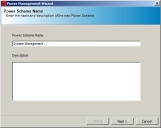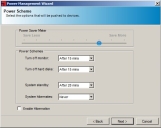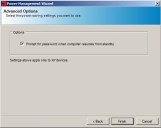The Power Management Wizard
The Power Management Wizard allows you to create a patch to manage power settings for workstations within a network. Using this simplified power policy creation method, you can manage the enforcement of environmentally friendly policies in distributed environments.
Using the Power Management Wizard allows you to create a patch to manage power settings. To deploy packages containing power management policies to applicable endpoints you use the Deployment Wizard within the Ivanti Endpoint Security.
For more information about deployments, refer to Creating an Endpoint Deployment or Creating a Group Deployment in the Endpoint Security: Patch and Remediation Help.
A package containing a power management policy can have its behavior changed by selecting behavior options. For instance, you may want to completely uninstall a power management policy from an endpoint. The options are found in the Package Deployment Behavior Options page within the Deployment Wizard.
Important: To completely remove a power management policy on an endpoint, you would choose uninstall the package and debug mode behavior options before deploying the package to all applicable endpoints. For additional information on changing deployment behavior options, refer to Selecting Deployment Behavior Options in the Endpoint Security: Patch and Remediation Help.
Using the Power Management Wizard
The Power Management Wizard allows the administrator to set local power policy settings on all workstations within the network.
- Select Tools > Power Management Wizard.
The Power Scheme Name page of the Power Management Wizard window opens.
- Type a unique name in the Power Scheme Name field.
The default name is System Management -. - Type a description of the power scheme in the Description field.
- Click Next.
The Power Scheme page opens.
- [Optional] Select the Power Saver Meter icon and slide it to a desired power saver setting. The Power Schemes settings will automatically adjust based on the slider adjustment level.
- Select the Power Schema options.
- Select after how long the monitor will be switched off from the Turn off monitor drop-down list.
- Select after how long the hard disk will be switched off from the Turn off hard disks drop-down list.
- To force devices into standby mode after a specific period, select the desired time from the System standby drop-down list.
- To force devices to go into hibernate mode after a specific period, select the desired time from the System hibernates drop-down list.
- [Optional] To enable hibernation, select the Enable Hibernation check box.
- Click Next.
The Advanced Options page opens.
- [Optional] To require the user to log into the device when waking it from standby, ensure the Prompt for password when computer resumes from standby check box is selected.
This option is selected by default. - Click Finish.
The Advance Option page closes and the Patch Properties page displays. - [Optional] The Patch Properties page displays properties associated with the selected patch.
Review and edit the patch properties as needed. - Select File > Save.
The patch is stored within the Ivanti Endpoint Security server.
When a device enters hibernation, a snapshot of the device settings and memory content of the device is taken. The information is saved to a local hard disk prior to the device shutting down. When you restart the device, all the settings and memory content are restored to their original state.
For information on Patch Properties, refer to The Patch Properties Page.
A patch is created to manage power settings for workstations.
To complete the deployment process, you deploy package content using the Deployment Wizard to applicable endpoints.
Refer to Creating an Endpoint Deployment or Creating a Group Deployment in the Ivanti Endpoint Security: Patch and Remediation User Guide (https://www.ivanti.com/support/product-documentation) for deployment information.